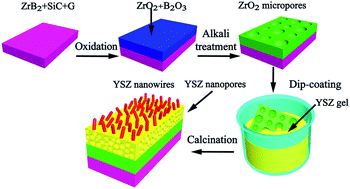Enhanced thermal shock resistance of ultra-high temperature ceramic by biomimetic surface modification†
Abstract
The manipulation of the heat flow in a ceramic matrix composite is of great importance in industrial and academic fields. Energy flow, as a typical behavior of heat motion in ceramic surfaces can be confined within specific sites during thermal shock experiments, which weakens the temperature gradient distribution, and hence suppresses the crack propagation. The heat flow can be rationally controlled by the introduction of a nanostructured surface with a diverse forced convection coefficient and heat transfer resistance. Taking inspiration from a nanofin surface, yttria-stabilized zirconia (YSZ) nanostructures were fabricated using the sol–gel method. This bio-inspired coating exhibits a high forced convection coefficient (2.884 times) and high heat transfer resistance (30 times) because of the existence of irregular nanowires arrays and a porous nanostructure. The introduction of the nanostructured coating resulted in the rapid depression of the thermal gradient and stress concentration, and the crack propagation was also effectively suppressed. This sol–gel coating method effectively enhanced the thermal shock resistance of the ceramic materials, and indicates the potential for the application of ceramics in extreme environments.


 Please wait while we load your content...
Please wait while we load your content...